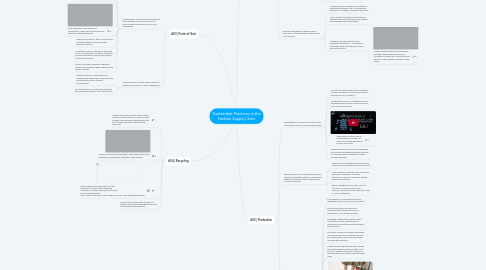
1. #03 | Point-of-Sale
1.1. Technologies can help to trace an apparel's origin precisely and enables a learning process about durability and Life Cycle Assessment.
1.1.1. Product origin tracking is the publishing of a list where products were made including pictures.
1.1.2. RefScale is a technology that measures the environmental impact of individual clothing
1.1.3. AI helps to analyze dust sample to determine the geographic production site.
1.1.4. RFID technology can used to link information of each step of production by using blockchian technology
1.1.5. Webcams and the IoT help to monitor and audit the factories compliance with working conditions
1.1.6. Companies include customers in the value chain for sustainable clothing by donations or recycling platform and let them decide of product's designs
1.1.7. GDPR issues and the general regulatory need to be considered when implementing these practices.
1.2. Technology also enables fashion brands to initiate new vertical and sales-touchpoints.
1.2.1. Digital clothing for virtual events will capitalize the design and IP and have little environmental impact (energy consumption).
1.2.2. 3D Printing allow for customized products and reduce the waste of not-sold products.
2. #04 | Recycling
2.1. Closed-loop systems utilize used clothing instead of virgin materials to produce new clothing, which prevents value destruction due to waste and saves environmental resources.
2.2. The 6R model helps to implement sustainable practices by analyzing and evaluating sustainable opportunities.
2.3. New measurement standards (MSI) and tools help to identify the sustainable footprint of clothing and allows to improve the sustainable impact. Nike Unveils New App to Help Designers Create More Sustainable Apparel
2.4. Global Impact model helps to helps to address sustainability throughout the tiers and in different perspectives.
3. #02 | Production
3.1. Sustainability is necessary to sustain in the future given customer preferences change
3.1.1. A customer-centric approach is mandatory to allow customers to choose (e.g. trade-in, recycle drop-off in outlets,...)
3.1.2. If integrated correctly, sustainability along the supply chain results in lower costs and more customer demand.
3.1.3. Alternative products such as Programmable Clothing can help to counteract shortening product life cycles
3.1.4. Fashion brands have not only responsibility to implement sustainable practices but also to communicate the message to create greater awareness
3.2. Reverse logistics is a challenge that implies indirect sustainability effects on sustainable apparel (e.g. emission due to return policy of "serial returners")
3.2.1. Smart mirrors and augmented reality avoid customers order different colours and sizes
3.2.2. Most profitable customers are often those, who return frequently. Incentive mechanisms need to move them change their return behaviour.
3.2.3. Return management accounts for up to 10% of SC costs and offer a huge economic incentive to make this part of the SC more sustainable.
3.3. The whole supply chain needs to be analyzed to get a transparent overview where is what pollution created.
3.3.1. Due diligence of raw material sourcing makes the initial process more transparent.
3.3.2. Energy and water consumption of alternative raw materials need to be evaluated to not just shift pollution.
3.3.3. Packaging materials (e.g. plastic wraps) and other non-vital materials can be eliminated or substituted with sustainable counter-parts.
3.3.4. One other concern are working conditions: we need to make sure consumers do not buy sustainable product manufactured in unsustainable factories.
3.3.5. Fashion brands need to track and manage the sustainability processes of their Tier-1 to Tier-n-suppliers to ensure compliance with regulations along the complete supply chain
3.3.6. One best practice example of complete sustainability implementation is Rothy's: Sustainability
3.3.7. Grupo Inditex does a lot of sustainability activities. Sustainable materials - inditex.com
4. #01 | Raw Materials & Demand Forecasting
4.1. Sustainable Raw Materials alone are not enough, the whole SC needs to change
4.1.1. Processing of raw material (e.g., fermenting, dyeing, sewing) leave a negative ecological footprint (use of chemicals) and inhibit social development (working conditions).
4.1.2. Sustainability targets and long-term strategies (e.g. emission strategy) support the commitment towards sustainability.
4.1.3. Governmental regulations and recycling quotas facilitate the introduction of sustainable products.
4.1.4. Alternative raw materials are still a niche and new suppliers and sources need to be planned and controlled carefully to avoid stock-outs and match supply & demand.
4.1.5. Apparel consist of different materials, the procurement for alternative raw materials gets more complex, as the example of Hugo Boss’ Piñatex Sneakers shows https://www.hugoboss.com/men-vegan-shoes/
4.1.6. Due diligence of raw material sourcing makes the process more transparent.
4.1.7. The amount of suppliers for sustainable raw materials is still limited.
4.2. Customer perception toward products made out of alternaitve raw materials need to be ensured.
4.2.1. Communication of quality and durability of alternative materials is key to increase the offering of completely sustainable products.
4.2.2. Luxury brands can create a market pull by experimenting with alternative raw material and leveraging their brand equity.
4.2.3. Customers are still hesitant to buy sustainable alternatives - is company's motivation limited as they do not see a clear opportunity?
4.2.3.1. Culture and brand need to be aligned to leverage sustainability as a driver for innovation to affect top- and bottom-line results. As the Patagonia business model shows.
